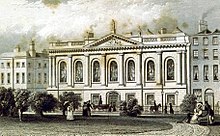
Abraham Colles was Professor of Anatomy, Surgery and Physiology at the Royal College of Surgeons in Ireland (RCSI) and the President of RCSI in 1802 and 1830. A prestigious Colles Medal & Travelling Fellowship in Surgery is awarded competitively annually to an Irish surgical trainee embarking on higher specialist training abroad before returning to establish practice in Ireland.

Sir Philip Crampton, 1st Baronet, FRSMRCSI was an eminent Irish surgeon and anatomist. He was President of the Royal College of Surgeons in Ireland (RCSI) in 1811, 1820, 1844 and 1855.
Richard Carmichael MRCSI MRIA was an Irish surgeon, medical writer and philanthropist.

John Whiteway was a Dublin surgeon who was the second president of the Royal College of Surgeons in Ireland (RCSI) in 1786.

Robert Bowes was the President of the Royal College of Surgeons in Ireland (RCSI) in 1787. He was Surgeon to the Charitable Infirmary, Inns Quay, Dublin, and also Surgeon to Simpson's Hospital. He was a member of the Dublin Society of Surgeons, who petitioned the King in 1781 for the foundation of the Royal College of Surgeons.

Philip Woodroffe was the resident surgeon at Dr Steevens' Hospital in Dublin for over 30 years. Several eminent surgeons were apprenticed to him. He was the president of the Royal College of Surgeons in Ireland (RCSI) in 1788.

Ralph Smith O'bré was an Irish physician who was the president of the Royal College of Surgeons in Ireland (RCSI) in 1790. He served as an army surgeon before setting up practice in Dublin where he became wealthy. He invented a popular double tracheostomy tube.

Solomon Richards was an Irish surgeon who served four terms as president of the Royal College of Surgeons in Ireland (RCSI) in 1794, 1803, 1808, and 1818. He achieved fame by performing a tracheotomy in public for which act he featured in a satirical poem in The Metropolis. He was praised for his philanthropy and noted for his puns and bon mots. He was said to be the "fattest surgeon in the United Kingdom".

York Street is a street in Dublin in the Republic of Ireland that runs between Aungier Street in the west and St Stephen's Green in the east.

Robert Moore Peile was the president of the Royal College of Surgeons in Ireland (RCSI) in 1798 and 1816.

Robert Hamilton was the president of the Royal College of Surgeons in Ireland (RCSI) in 1805.

Patrick Cusack Roney or Rooney was an Irish physician who was President of the Royal College of Surgeons in Ireland (RCSI) in 1814 and 1828.

James Henthorn was the president of the Royal College of Surgeons in Ireland (RCSI) in 1822.

John Timothy Kirby was the president of the Royal College of Surgeons in Ireland (RCSI) in 1823 and 1834.

Alexander Read was the president of the Royal College of Surgeons in Ireland (RCSI) in 1825 and 1835.

James William Cusack was the president of the Royal College of Surgeons in Ireland (RCSI) in 1827, 1847, and 1858.

William Auchinleck was the president of the Royal College of Surgeons in Ireland (RCSI) in 1829.

Thomas Edward Beatty was an Irish physician, and the president of the Royal College of Surgeons in Ireland (RCSI) in 1850.

Andrew Ellis was the president of the Royal College of Surgeons in Ireland (RCSI) in 1849.

William Hartigan, MD, MRCSI (1756–1812), was an Irish surgeon.






